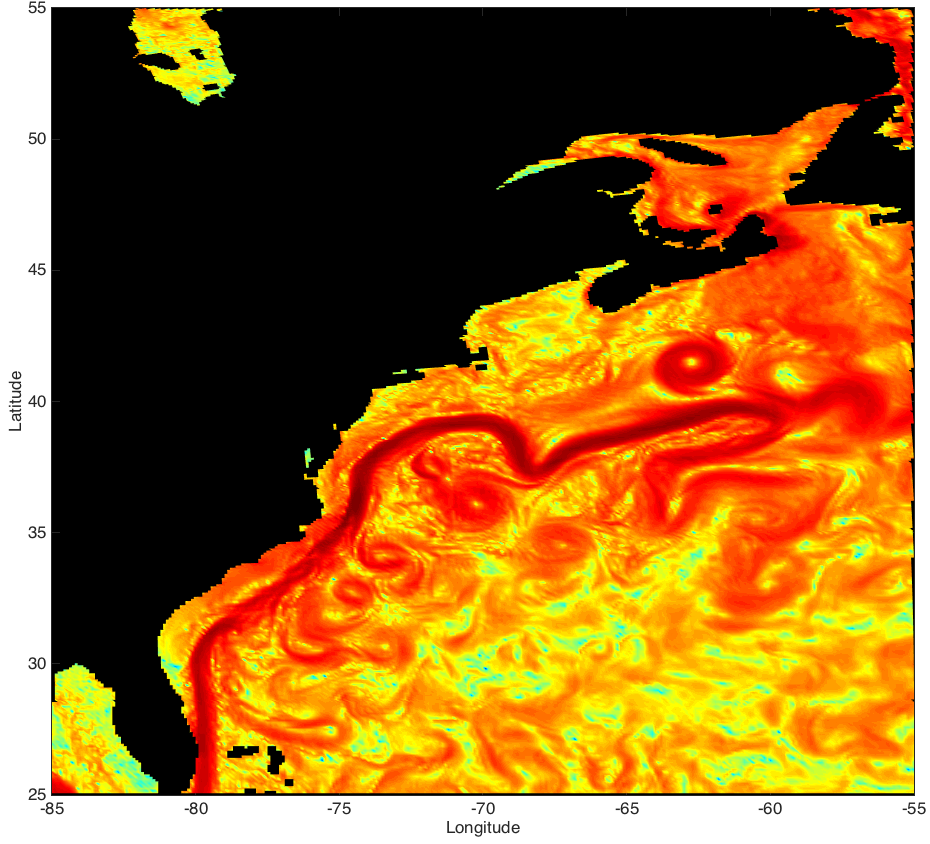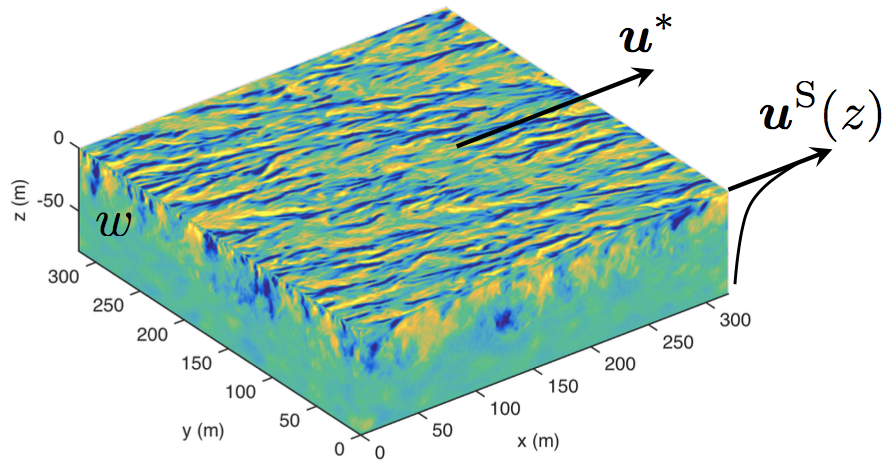Baylor Fox-Kemper, Associate Professor of Earth, Environmental, and Planetary Sciences, is keenly aware of the ways that the ocean and atmosphere interact to drive both the weather systems of today and the climate change of tomorrow. He and his team study turbulence, the disordered, variable features that participate actively in the transfer of energy, carbon, and heat between the water and air. Their goal is to improve the way our most powerful climate models simulate these features, giving scientists the tools to explore current phenomena and predict future changes in climate.
%20(1).jpg)
Ocean and energy
Earth's climate is driven primarily by the sun, but it is the large-scale ocean currents and winds that redistribute this solar warming from its area of highest intensity, the equator, to the cooler midlatitudes and polar regions. Most of the absorbed heat of the sun is stored in the oceans, to be released at night or during winter, behavior that adds to the equalizing effect.
But it is actually on the smallest scales that the air and water meet, exchanging heat energy through turbulent features like swirling eddies, small storms, and even spray droplets.
"At any moment in the ocean, there are hundreds of little eddies on any slice across a basin, and they're all kind of mixing and churning and extracting energy," explains Fox-Kemper. "You wouldn't get any air-sea exchange unless you had that kind of turbulence."
In some cases, that turbulence quickly becomes noticeable on macroscopic scales. For instance, the energy stored in warm eddies gradually heats and and humidifies the air above, leading to the formation of clouds and precipitation and generating weather systems that ride along.

"Those eddies can affect local climate intensely," says Fox-Kemper. "If it's a warm eddy, then you'll have a warm atmosphere above. That will be different than having the average ocean temperature exposed to the average atmospheric temperature. And so it has different clouds, it has different precipitation, it has different weather."
"If you're on a boat and go through one of these, you can tell," he adds. "In a matter of hours you'll go from a cold day to a warm day as you cross over one of these little regions."
The briny reservoir
The ocean's ability to store heat in this way is the primary reason that it has such a powerful impact on both local weather patterns and global climate.
"Water stores heat energy much much more effectively than almost any material we know of," explains Fox-Kemper. "The upper about three and a half meters of the ocean have the same heat capacity as the whole atmosphere—and the ocean is about four kilometers deep."
The ocean's ability to store excess heat will continue so long as liquid water is present on Earth. But the ocean also acts as another storage reservoir, and one that is much more fragile: a sink for carbon.
In fact, the ocean's capacity to store carbon is vital to keeping global temperature changes within a manageable range. As Fox-Kemper explains, the ocean takes up about 90% of the heat energy and half of all the carbon emitted into the atmosphere.
"If all of the excess energy retained by the Earth under global warming was put into the atmosphere only, we would be having double digit global warming," he says. "What keeps it to just a few degrees, or a degree and a half, is because the ocean takes up the vast majority of the excess energy."
When carbon goes into the ocean, some of it is incorporated into biological forms, such as the cells or shells of marine organisms. The rest of it is dissolved and transformed into chemical compounds, which make the ocean more acidic.
If temperatures rise dramatically over the next few centuries or decades, however, the delicate chemical balance of today's oceans could change. Some sea creatures, such as corals, have evolved in nearly constant temperature environments, so they are very sensitive to changes in temperature and acidity. Coral bleaching and death are closely related to human-induced climate change.
Furthermore, the changing climate may change the capability of the ocean to act as a carbon reservoir.
"The amount of carbon dioxide and carbonate and bicarbonate the ocean can hold is temperature and salinity dependent," explains Fox-Kemper. "So if you change the temperature of the ocean, you might actually release carbon back into the atmosphere."
"Or," he continues, "If you change the pattern of currents, then you might bring up carbon-rich waters into a place where they're triggered into releasing it, rather than taking carbon-poor waters, filling them up with carbon, and then sinking them for a while."
Resolving uncertainty
Although the general impact of these processes is well-known, scientists are still trying to determine their exact effects.
"If you change the climate system, that changes the currents, that changes the air-sea exchanges of carbon—that part, we're still figuring out," says Fox-Kemper. "That's part of why we are moving into a new generation of climate models where the carbon cycle is directly represented."

Climate models have been around for decades; but it wasn't until recently that scientists could start to predict the impacts of individual factors on local climate change. In recent decades, more and more layers have been added to climate simulations—rainfall, snowfall, solar radiation, atmospheric factors, sea ice, land ice, ocean features, the carbon cycle, and more—in an effort to understand how individual processes affect one another in a changing global environment. The ultimate goal is to simulate a very complex system of feedbacks, and the ways in which that system might be sensitive to change.
The result is a sort of ‘experimental' version of Earth, which can be tweaked to corroborate short-term observations and predict long-term climate patterns.
"In a model, you can sever connections and see what the consequences are, or add new connections and see what the consequences are," says Fox-Kemper. "That's a very powerful way of exploring how the system as a whole behaves."
It also enables scientists to project into the future and observe many different outcomes, depending on our behavior today. For instance, scientists can ask what is likely to happen if societies produce a certain amount of carbon, decrease or increase their emissions, or switch entirely to renewables, and obtain a relatively sound prediction of the climate's response anywhere from 10 to 10,000 years in the future.
Collaboration is key
Fox-Kemper and his team are currently working to accurately represent the effects of surface waves in the Community Earth System Model (CESM), a product of the Department of Energy, the National Center for Atmospheric Research and hundreds of university collaborators. Fox-Kemper himself is Co-Chair of the Ocean Model Working Group, the coalition in charge of optimizing the ocean component within the CESM.
"What our group is trying to do," he explains, "is to make better, more accurate representations of [air-sea] exchanges and turbulence to better quantify how much carbon, how much momentum, how much energy, comes and goes between the atmosphere and the ocean."
Fox-Kemper explains that this work has greatly improved multiple components of climate models, making them both more accurate and more predictively sound. In some ways, he and his team have been surprised by the results.
"The majority of things that we find out are that certain [ocean] processes are more important to the climate system as a whole than we thought they were," he says.
He is clear, however, that the benefits of climate models go far beyond improving scientists' understanding of the underlying physics.
"Not every impact of climate change on the ocean is related to the ocean's role in the climate system," he says. "A lot of it is also that the ocean is an enormous ecosystem with a lot of diversity, and a lot of people depend on fish for food. And so it has all these socioeconomic, environmental impacts that are separate from its direct effect back onto the climate system."
Reflecting on these impacts, Fox-Kemper suggests that the changing ocean—long a mainstay of geoscientific study—is actually ripe for examination within the interdisciplinary environment of IBES.
"It would be nice to have an economic or equity or societal lens on how to think about those problems," he continues. "We're emphasizing the physics, but actually, these are multidisciplinary problems at the root."
The exact effects that a warming world will have on our oceans, or on those who rely on its resources, are as yet unknown; in the meantime, Fox-Kemper and his team are hard at work honing their piece of the climate puzzle. They are resolute in their mission to ensure the accuracy of today's climate simulations.
His explanation is simple: "Since we have only one Earth and we don't care to endanger it by experimenting with it, it would be great if we had models that we could experiment with safely."